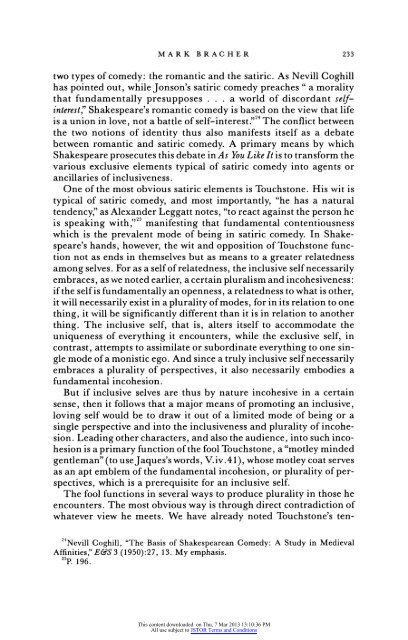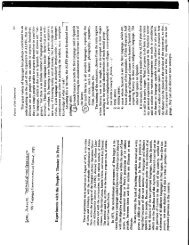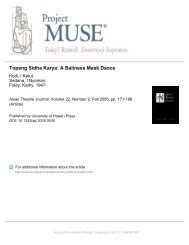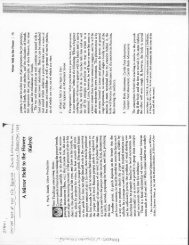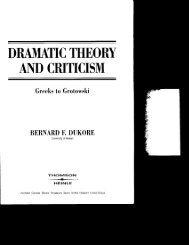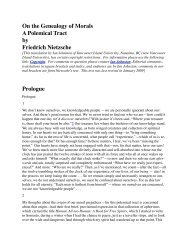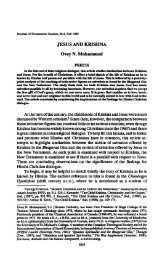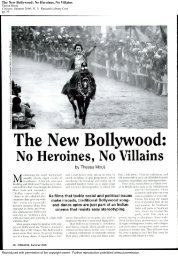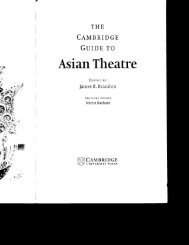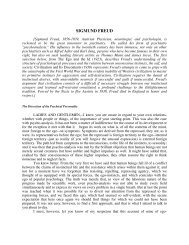Contrary Notions of Identity in As You like It - Yavanika
Contrary Notions of Identity in As You like It - Yavanika
Contrary Notions of Identity in As You like It - Yavanika
Create successful ePaper yourself
Turn your PDF publications into a flip-book with our unique Google optimized e-Paper software.
MARK<br />
BRAC HER23<br />
233<br />
two types <strong>of</strong> comedy: the romantic and the satiric. <strong>As</strong> Nevill Coghill<br />
has po<strong>in</strong>ted out, while Jonson's satiric comedy preaches " a morality<br />
that fundamentally presupposes . . . a world <strong>of</strong> discordant self<strong>in</strong>terest,<br />
Shakespeare's romantic comedy is based on the view that life<br />
is a union <strong>in</strong> love, not a battle <strong>of</strong> self-<strong>in</strong>terest."24 The conflict between<br />
the two notions <strong>of</strong> identity thus also manifests itself as a debate<br />
between romantic and satiric comedy. A primary means by which<br />
Shakespeare prosecutes this debate <strong>in</strong> <strong>As</strong> <strong>You</strong> Like <strong>It</strong> is to transform the<br />
various exclusive elements typical <strong>of</strong> satiric comedy <strong>in</strong>to agents or<br />
ancillaries <strong>of</strong> <strong>in</strong>clusiveness.<br />
One <strong>of</strong> the most obvious satiric elements is Touchstone. His wit is<br />
typical <strong>of</strong> satiric comedy, and most importantly, "he has a natural<br />
tendency," as Alexander Leggatt notes, "to react aga<strong>in</strong>st the person he<br />
is speak<strong>in</strong>g with,"25 manifest<strong>in</strong>g that fundamental contentiousness<br />
which is the prevalent mode <strong>of</strong> be<strong>in</strong>g <strong>in</strong> satiric comedy. In Shakespeare's<br />
hands, however, the wit and opposition <strong>of</strong> Touchstone function<br />
not as ends <strong>in</strong> themselves but as means to a greater relatedness<br />
among selves. For as a self <strong>of</strong> relatedness, the <strong>in</strong>clusive self necessarily<br />
embraces, as we noted earlier, a certa<strong>in</strong> pluralism and <strong>in</strong>cohesiveness:<br />
if the self is fundamentally an openness, a relatedness to what is other,<br />
it will necessarily exist <strong>in</strong> a plurality <strong>of</strong> modes, for <strong>in</strong> its relation to one<br />
th<strong>in</strong>g, it will be significantly different than it is <strong>in</strong> relation to another<br />
th<strong>in</strong>g. The <strong>in</strong>clusive self, that is, alters itself to accommodate the<br />
uniqueness <strong>of</strong> everyth<strong>in</strong>g it encounters, while the exclusive self, <strong>in</strong><br />
contrast, attempts to assimilate or subord<strong>in</strong>ate everyth<strong>in</strong>g to one s<strong>in</strong>gle<br />
mode <strong>of</strong> a monistic ego. And s<strong>in</strong>ce a truly <strong>in</strong>clusive self necessarily<br />
embraces a plurality <strong>of</strong> perspectives, it also necessarily embodies a<br />
fundamental <strong>in</strong>cohesion.<br />
But if <strong>in</strong>clusive selves are thus by nature <strong>in</strong>cohesive <strong>in</strong> a certa<strong>in</strong><br />
sense, then it follows that a major means <strong>of</strong> promot<strong>in</strong>g an <strong>in</strong>clusive,<br />
lov<strong>in</strong>g self would be to draw it out <strong>of</strong> a limited mode <strong>of</strong> be<strong>in</strong>g or a<br />
s<strong>in</strong>gle perspective and <strong>in</strong>to the <strong>in</strong>clusiveness and plurality <strong>of</strong> <strong>in</strong>cohesion.<br />
Lead<strong>in</strong>g other characters, and also the audience, <strong>in</strong>to such <strong>in</strong>cohesion<br />
is a primary function <strong>of</strong> the fool Touchstone, a "motley m<strong>in</strong>ded<br />
gentleman" (to useJaques's words, V.iv.41), whose motley coat serves<br />
as an apt emblem <strong>of</strong> the fundamental <strong>in</strong>cohesion, or plurality <strong>of</strong> perspectives,<br />
which is a prerequisite for an <strong>in</strong>clusive self.<br />
The fool functions <strong>in</strong> several ways to produce plurality <strong>in</strong> those he<br />
encounters. The most obvious way is through direct contradiction <strong>of</strong><br />
whatever view he meets. We have already noted Touchstone's ten-<br />
24Nevill Coghill, "The Basis <strong>of</strong> Shakespearean Comedy: A Study <strong>in</strong> Medieval<br />
Aff<strong>in</strong>ities[" E&S 3 (1950):27, 13. My emphasis.<br />
25P. 196.<br />
This content downloaded on Thu, 7 Mar 2013 13:10:36 PM<br />
All use subject to JSTOR Terms and Conditions


